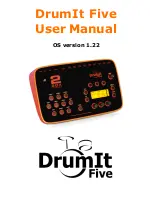
V
oice mode
Song mode
P
a
tt
er
n mode
Mixing mode
Mast
er mode
Utility mode
F
ile mode
P
erf
or
mance
mode
Sampling
mode 1
Sampling
mode 2
R
e
fe
rence
File Management (File mode)
MOTIF XF Reference Manual
235
n
To go down from the current directory in the File window
(page 237), move the cursor to the desired directory in the
Directory/File list then press the [ENTER] button. To go up from
the current directory, move the cursor to the top line in the
Directory/File list then press the [ENTER] button.
The location of the directories (folders) and files currently
indicated at the “Dir” line on the display is referred to as a
“path.” This indicates the current directory, what device it
belongs to, and in which folder(s) it is contained. “Directory
C” illustrated above is described as path “USB_HDD/A/C.”
Refers to the operation so that an external memory device
becomes active for the instrument. The USB storage
device is automatically mounted as soon as connected to
the USB TO DEVICE connector on the rear panel of the
MOTIF XF. The hard disk drive of the computer connected
to the MOTIF XF via the network can be mounted in the
Mount display (page 239).
The operation of initializing a storage device (such as a
hard disk) is referred to as “format.” The File mode of the
MOTIF XF allows you to format the USB memory storage
device connected to the USB TO DEVICE connector. The
format operation erases all data from the target memory
device and is irreversible.
“Save” means that the data created on the MOTIF XF is
saved to the external memory device as a file, while “Store”
means that the data created on the MOTIF XF is stored to
internal memory. “Load” means that the file on the external
memory device is loaded to internal memory.
File types that can be handled by
the MOTIF XF
The MOTIF XF supports various file types that can be
saved and loaded. Refer to the following two lists.
File types that can be saved
* Automatically assigned to the saved file.
Path
Mount
Format
Save/Load
Type
File
extension*
Description
All
.X3A
All data in this synthesizer’s internal User
Memory (Flash ROM) is treated as a single
file, and can be saved to the USB storage
device.
All Voice
.X3V
All the User Voice data in this synthesizer’s
internal User Memory (Flash ROM) is
treated as a single file, and can be saved to
the USB storage device. Also the
Waveforms obtained via the Sampling
function and assigned to any of the Voices
are saved together.
All
Arpeggio
.X3G
All the User Arpeggio data in this
synthesizer’s internal User Memory (Flash
ROM) is treated as a single file, and can be
saved to the USB storage device.
All Song
.X3S
All the User Song data in this synthesizer’s
internal User Memory (Flash ROM) is
treated as a single file, and can be saved to
the USB storage device. The Song data
includes Mixing settings, Mixing Voices
and Sample Voices.
All Pattern
.X3P
All the User Pattern data in this
synthesizer’s internal User Memory (Flash
ROM) is treated as a single file, and can be
saved to the USB storage device. The
Pattern data includes Mixing settings,
Mixing Voices and Sample Voices.
SMF
.MID
Sequence track (1 – 16) and Tempo track
data of Songs or Patterns created in the
Song/Pattern mode can be saved to the
USB storage device as Standard MIDI File
(format 0) data.
All
Waveform
.X3W
All the Waveform data created via the
Sampling function can be saved as a
single file. The Waveform data includes all
the Samples on SDRAM and the optional
Flash Memory Expansion Modules
(FL512M/FL1024M). Note that the Samples
on the FL512M/FL1024M may not be
included in a file of this type because you
can select whether or not these are to be
saved before executing the Save operation.
WAV
.WAV
A Sample created in the Sampling mode
can be saved to the USB storage device as
a WAV file (Windows audio format).
AIFF
.AIF
A Sample created in the Sampling mode
can be saved to the USB storage device as
an AIFF file (Mac audio format).




































